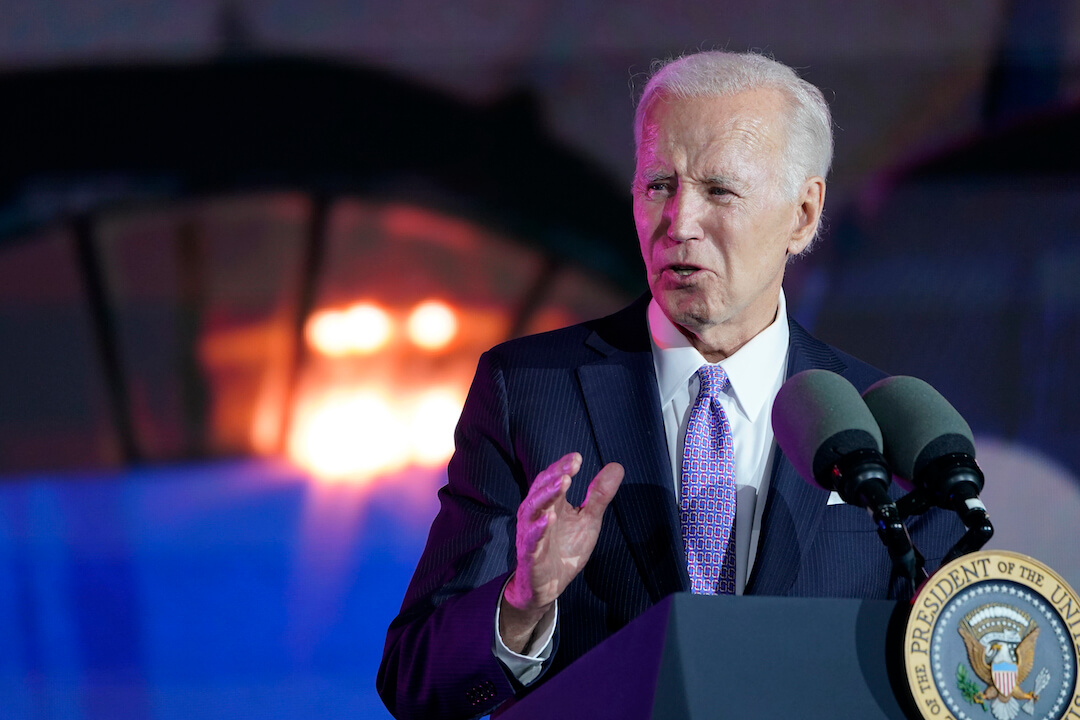U.S. federal courts, like the one in which former President Donald Trump was arraigned on Tuesday, are generally unfriendly to journalists and interested members of the public.
They don’t allow cameras or audio feeds. It’s not possible to listen to them on a phone line. Artists’ drawings are often the only images available from inside federal courtrooms. The chief judge in Tuesday’s case in Miami went a step further and barred reporters in attendance from carrying smartphones or laptops, even to take notes.
So CNN got crafty.
The network hired local high school students to work as production assistants. CNN’s Oliver Darcy reports that several students sat in an overflow room — the only place where journalists and the public could listen in on the case besides the courtroom itself — with several CNN reporters.
“As the hearing unfolded and developments transpired,” Darcy writes, the reporters “jotted down their reporting on notepads, tearing off sheets with urgent news, and handing it to one of the students. The students then ran the reporting to one of their classmates who was standing by at one of the courthouse’s only two pay phones.
“But there was a twist: the pay phones at the courthouse could only dial local telephone numbers. To overcome the final obstacle, CNN’s staff devised a plan to have the production assistant dial his own personal cell phone, which was located in a nearby RV that the network was using as a mobile headquarters.”
A news director in the RV typed up the relay and shared the information with CNN’s Washington, D.C., bureau. Senior leaders then cleared the reporting for the air.
“And, from there,” Darcy writes, “it was finally communicated to CNN’s anchors, who delivered the news to viewers across the world.”
It was a remarkable production that only had to happen because of the opaque rules of the U.S. federal court system.
Trump TV
TV news networks provided another day of wall-to-wall Trump coverage Tuesday, John Koblin reports for The New York Times.
“Unlike the arraignment in April, there was decidedly a lack of useful footage. There were no shots of Mr. Trump entering the courthouse — his motorcade entered a garage — nor were there any images inside the federal building,” Koblin writes. “The networks relied instead on images of demonstrators outside the courthouse.”
All this Trump news has been good for MSNBC, which ranked first among the cable news networks in prime time for the week. It was the first time MSNBC achieved that in more than two years, Koblin writes.
Meanwhile, Trump supporters booed and tossed out a Sky News reporter at an event in Miami. For HuffPost, Lee Moran with “‘Get Out You Stupid B***h’: Donald Trump Crowd Turns On Journalist Over Question.”
Say what?

President Joe Biden speaks during a Juneteenth concert on the South Lawn of the White House in Washington, Tuesday, June 13, 2023. (AP Photo/Susan Walsh)
A chyron on Fox News has stunned news watchers with some unusually charged language, even from a network that recently settled a lawsuit for $787.5 million to avert a defamation trial.
President Joe Biden was giving remarks at the White House on Tuesday evening, hours after Trump was formally charged and at the same time Trump was giving a speech from his golf club in Bedminster, New Jersey.
A chyron below a split screen of the two read: “Wannabe dictator speaks at the White House after having his political rival arrested.”
The message appeared for almost 30 seconds. A spokeswoman for Fox News later provided a statement, “The chyron was taken down immediately and was addressed.”
Insider journalists end strike
Unionized journalists at Insider announced Wednesday afternoon that they had reached a tentative agreement on a first contract with the company and would end their open-ended strike.
More than 250 employees — including reporters, editors, video producers and copy editors — walked off the job June 2, alleging that the company had unilaterally changed workers’ health insurance in violation of federal labor law. Their 13-day strike, the longest digital media work stoppage in history, culminated in an agreement with the company that includes more than $400,000 worth of health care cost reimbursements.
Other protections included in the contract are a $65,000 wage floor, annual raises of at least 3%, a layoff moratorium for the rest of the year and the stipulation that employees cannot be terminated without “just cause.” The journalists, who are represented by the NewsGuild of New York, must vote to ratify the contract.
During the strike, managers and nonunion employees wrote stories to keep the site fresh. (Insider, a global outlet, has reporting staff outside of the United States who are not unionized.) Editors also reposted old content and, at one point, published a striking worker’s incomplete draft article.
Meanwhile, union members published updates to their strike publication, “Business Outsider,” including an interview with Semafor co-founder and former BuzzFeed News editor-in-chief Ben Smith.
The Insider Union’s strike followed a one-day walkout in April after the company announced it would lay off 10% of its staff, including 60 union members. The two parties subsequently negotiated the number of union layoffs down to roughly 40 people.
Though one-day walkouts have become an increasingly common tactic among media unions, open-ended strikes are relatively rare. The last digital media union to go on strike was Gizmodo Media Group Union, which represents employees at Gizmodo, Jezebel, The Root and three other newsrooms. Those journalists struck in March 2022 for less than a week. Meanwhile, reporters and other noneditorial workers at the Pittsburgh Post-Gazette are still on strike, eight months after they first walked off the job.
Insider top editor tears down pro-union posters
Days before Insider journalists ended their open-ended strike, which had reached its second week, top editor Nicholas Carlson bicycled around Brooklyn, tearing down pro-union posters from lamp posts and mailboxes.
The posters, with the text “HAVE YOU SEEN THIS MILLIONAIRE?” accompanied by a headshot of Carlson and a message from the union, were specifically placed in Carlson’s Windsor Terrace neighborhood of Brooklyn. Nearly identical posters showing Insider CEO Henry Blodget were placed in his neighborhood, as well.
The New York Post reported on Carlson’s poster-tearing on Tuesday afternoon. A 56-second clip obtained by the Post shows Carlson, wearing a bike helmet and standing astride a Citi Bike with a basket stuffed with the posters, speaking with Insider employees who recognized him.
“Nicholas is a big boy and can handle attacks made on him on social media, but he was quite alarmed to see the posters plastered all over his neighborhood, including especially around his seven-year-old son’s school,” an Insider spokesman told the Post.
The strike, which launched on June 2, caused more than 250 unionized employees to stop producing news content for Insider for two weeks.
News consumers across the globe are searching for and avoiding news
The annual Reuters Institute Digital News Report, based on data from six continents and 46 markets, was published this week and lays out key findings around how average people find information about the world around them.
The report highlights shifts in:
- How people access news.
- Perceptions of algorithms’ role in news.
- “Winner takes most” with subscriptions.
- Continued news avoidance.
The institute grounds its findings in current events: “This year’s report comes against the backdrop of a global cost-of-living crisis, a continuing war in the heart of Europe, and further climate instability across the world.”
Last year’s report looked at how people avoid the news. The main reason people avoid news was the depressing nature of particular topics — a third of users referenced this in the survey. For example, an increasing proportion of people both in the United States and Japan, around 15%, did not tend to engage with news and or social media on a weekly basis.
And while trust in news was not as low as it has been, the 2023 report indicated audiences’ preference for accessing news through tech platforms over going directly to news outlets. This accounts for search on social media, particularly video-led platforms like TikTok, but also through aggregators like Google News.
The survey asked whether news consumers prefer to start their news journey through search or directly through news sources. The latter fell by about 10 percentage points from last year. The researchers attributed this directly to younger people’s habits around using social media and aggregators.
“Our data show, more clearly than ever, how this shift is strongly influenced by habits of the youngest generations, who have grown up with social media and nowadays often pay more attention to influencers or celebrities than they do to journalists, even when it comes to news,” the report reads.
While last year’s findings point to a need to make news accessible and relevant, as well as giving disheartened news consumers agency, this year’s report indicates that news consumers have taken back some control through search.
The Reuters Institute for the Study of Journalism “Future of Journalism” podcast talked with Nic Newman, the lead author of the report, and co-author Rasmus Nielsen in a 30-minute podcast special (for those of you who have also become enamored with new ways and habits of consuming information beyond reading, much like the respondents in the survey).
¡Mira! ¡The Boston Globe!
The Boston Globe will drop its first newsletter Friday to be written in both English and Spanish, by Globe Opinion columnist Marcela García. It’s called ¡Mira! — in English, “Look!” In an announcement last month, García (who is also an associate editor and serves on the Globe editorial board) described the newsletter as her “once-a-week take on politics, policy, people — and pets!”
“It’s no secret that Boston is a majority-minority city where 1 in 5 Bostonians is Latinx,” García wrote. “Without question, the Hispanic community has become a meaningful part of the fabric of the city.” And yet, she pointed out, “there aren’t enough quality information sources to meet the demands and needs of the Latino population and the immigrant community at large.”
Earlier this year, Poynter reported that daily newspapers cut their Spanish-language outlets due to a variety of pressures like declines in advertising revenue. We’re curious to see where this effort by the Globe to serve their Spanish-speaking population takes them.
Media tidbits
- “While quite a bit of attention has been paid to CNN and Fox News’ ratings struggles and far-right Newsmax’s recent explosive growth, another cable outlet has seen an even more remarkable expansion in viewership,” Justin Baragona writes for The Daily Beast. “… For the month of May, NewsNation was up triple digits in both total primetime viewership and in the key advertising demographic of viewers aged 25-54.”
- Troubling treatment of a reporter at a Trump event in Miami. For HuffPost, Lee Moran with “‘Get Out You Stupid B***h’: Donald Trump Crowd Turns On Journalist Over Question.”
- For The Wall Street Journal, Simon J. Levien with “U.S. House Votes 422-0 to Demand Release of Evan Gershkovich.”
Today’s edition of the Poynter Report was written by Annie Aguiar, Amaris Castillo, Angela Fu, Josie Hollingsworth and Ren LaForme.
More resources for journalists
- Sign up for Beat Academy (Now-Oct. 19) (Webinar series) — You’ll get tips, sources, inspiration and ideas to cover emerging newsroom beats. Enroll now.
- Executive Leadership Summit (Oct. 2023) (Seminar) — Apply by Aug. 14.
- Level Up: Critical Skills for Local Reporters (Oct. 3-Nov. 14) (Seminar) — Apply by Aug. 31.
Have feedback or a tip? Email Poynter senior media writer Tom Jones at tjones@poynter.org.
The Poynter Report is our daily media newsletter. To have it delivered to your inbox Monday-Friday, sign up here.







